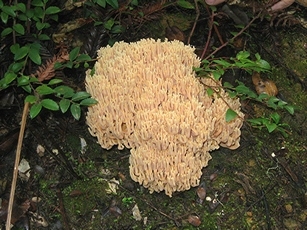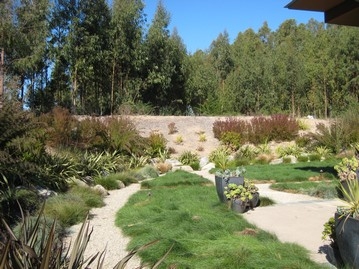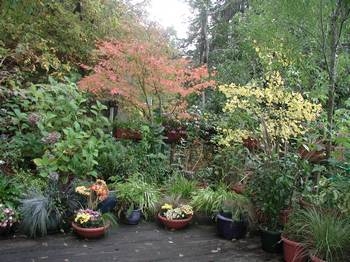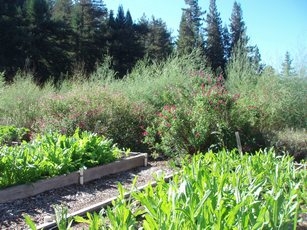Chestnuts roasting on an open fire. Jack Frost nipping at your nose. The garden's been put to rest for the winter covered with a nice blanket of compost. The recent wind storm provided me with lots of material to make a beautiful holiday wreath for the front door or swag to decorate a window. Wreaths are easy and fun to make. They cost virtually nothing and make wonderful gifts for family, friends and neighbors, too. I was invited to a neighbor's 8th annual holiday wreath making party. I could hardly wait.
Kinda like a barn raising party without the barn, this fun group gets together for the first two weekends in December each year to inspire each other to create wonderfully unique wreaths and other decorations from natural materials. Each crafter is encouraged to invite another friend or relative and as many as 32 people will be joining my neighbor, Barbara, for the fun over the next two weeks. Some will come from as far away as Folsom and Roseville and include both men and grandchildren who take part in the festivities.
Creative people amaze me. Amidst dozens of downed branches, the wreath makers started to work. Barbara and her husband started collecting foliage and berries weeks ago in their pick up truck. She laughed when she told me that this year they were very sad because they were unable to get trimmings from their favorite variegated holly as it was being guarded by a pit bull. Mostly they collect from neighbors trees. Green waste cans of friends might supply a wonderful mix of hydrangea flowers and other pruned goodies. Monterey cypress and pines from the Davenport area are coveted along with Hollywood junipers, cedar, leptospermum, eucalyptus sprays and variegated pittosporum foliage. Large piles of English laurel, purple hopseed bush, rosemary and bottlebrush surrounded us. Last year was the first for acacia branches as they didn't know if it would hold up but it worked great and is now a staple. Tristania leaves and berries are another new addition to the wreaths.
Barbara explained that she once took a floral making class at Cabrillo. "I got hooked", she says,"now I'm obsessed". Some "wreathers" as we're called work fast putting together bundles of mixed foliage with lightening speed and attaching them to the frame with wire on paddles. Others are more meticulous grouping each bundle of various foliage with exactly the same mix. That's pretty much it for required tools- gloves, clippers, a frame and paddle wire. A hot glue gun is a nice too for attaching accents like cones, berry clusters, driftwood, lichen, feathers, shells or flowers. Floral picks work nicely for small fruits like Meyer lemons, clementines or small pomegranates.
The record for most wreaths made in a single season is apparently held by Martha who created 7 in the course of two weeks to decorate her home and to give away as gifts. Our hostess, Barbara, holds the record for making the largest wreath which measured in at 36" and graced her front door last year. Wreaths for a front door, she explained, should be able to hold up to constant movement so she is careful not to use berries that might loosen and fall. California pepper and nandina berries usually work in this location. You can bet her front door this year will sport another marvelous creation.
Look outside your door for different shades of foliage and spent flower heads, With just a couple of bags worth of materials you can make wreaths with your kids for many of those on your Christmas list.

 ild mushrooms growing in this area that are edible there are just as many that are poisonous. Mistakenly ingesting them can cause death or liver damage so severe that a transplant would be needed for you to survive. In November, Santa Cruz County received the second report of a hospitalized person who became seriously ill after eating mushrooms collected in the La Selva Beach area. According to the press release, both illnesses were probably due to the mushroom Amanita phalloides. Other common poisonous mushrooms found throughout the county are Amanita ocreata and Galerina autumnalis.
ild mushrooms growing in this area that are edible there are just as many that are poisonous. Mistakenly ingesting them can cause death or liver damage so severe that a transplant would be needed for you to survive. In November, Santa Cruz County received the second report of a hospitalized person who became seriously ill after eating mushrooms collected in the La Selva Beach area. According to the press release, both illnesses were probably due to the mushroom Amanita phalloides. Other common poisonous mushrooms found throughout the county are Amanita ocreata and Galerina autumnalis. or feel the breeze of the wind. Hear the rainfall dripping from the redwoods or the winter wrens calling to each other under the canopy. Taste wild huckleberry or thimbleberries along a forest path. I’m grateful for the beauty of nature that visits my garden.
or feel the breeze of the wind. Hear the rainfall dripping from the redwoods or the winter wrens calling to each other under the canopy. Taste wild huckleberry or thimbleberries along a forest path. I’m grateful for the beauty of nature that visits my garden. Held at the University of California Cooperative Extension office in Watsonville and open to the public, the meeting lived up the the Master Gardener slogan to "Cultivate Knowledge... by extending research-based horticultural information". The speaker was Cliff Low, owner of Perry Laboratory in Watsonville. If you have ever wondered why your hedge is languishing despite your exquisite care you may need his services.
Held at the University of California Cooperative Extension office in Watsonville and open to the public, the meeting lived up the the Master Gardener slogan to "Cultivate Knowledge... by extending research-based horticultural information". The speaker was Cliff Low, owner of Perry Laboratory in Watsonville. If you have ever wondered why your hedge is languishing despite your exquisite care you may need his services. Bright trees and shrubs add color flashes to fall gardens. Sasanqua camellias have already started blooming and will continue to flower throughout the winter. In addition to asters and rudbeckia, Japanese anemones are the stars of the border at this time of year. The electric blue flowers of dwarf plumbago contrast with reddish leaves as night temperatures dip. Summer Snowflake viburnum, Encore azalea, Endless Summer hydrangea and loropetalum are blooming now, too.
Bright trees and shrubs add color flashes to fall gardens. Sasanqua camellias have already started blooming and will continue to flower throughout the winter. In addition to asters and rudbeckia, Japanese anemones are the stars of the border at this time of year. The electric blue flowers of dwarf plumbago contrast with reddish leaves as night temperatures dip. Summer Snowflake viburnum, Encore azalea, Endless Summer hydrangea and loropetalum are blooming now, too.  Linda Butler starts all her vegetables from seed, and grows year-round. Some are started directly in the beds while others are started in flats and transplanted later. Cole crops, such as broccoli, cauliflower and cabbage, would get eaten by bugs and birds would eat them as fast as they germinated so these are started in flats.
Linda Butler starts all her vegetables from seed, and grows year-round. Some are started directly in the beds while others are started in flats and transplanted later. Cole crops, such as broccoli, cauliflower and cabbage, would get eaten by bugs and birds would eat them as fast as they germinated so these are started in flats.